Southern Peninsula Wines: International Marketing Report
VerifiedAdded on 2019/09/23
|10
|2568
|493
Report
AI Summary
This report assesses international marketing opportunities for Southern Peninsula Wines, focusing on entering the Chinese market. It begins with an overview of the organization, including its vision, strategic goals, and capabilities, and identifies boutique premium wines as the product for the Chinese market. The report then analyzes the global business environment, highlighting market trends and developments in the wine industry, particularly the roles of New World and Old World producers. It examines trade patterns, policies, and agreements between Australia and China, emphasizing the China-Australia Free Trade Agreement (ChAFTA) and its impact on market entry. Finally, the report considers various environmental factors, including social, cultural, political, economic, technological, and e-commerce factors, impacting the organization's entry into the Chinese market, including the increasing adoption of wine in China, the rise of e-commerce and the impact of Chinese regulations on wine production and import.
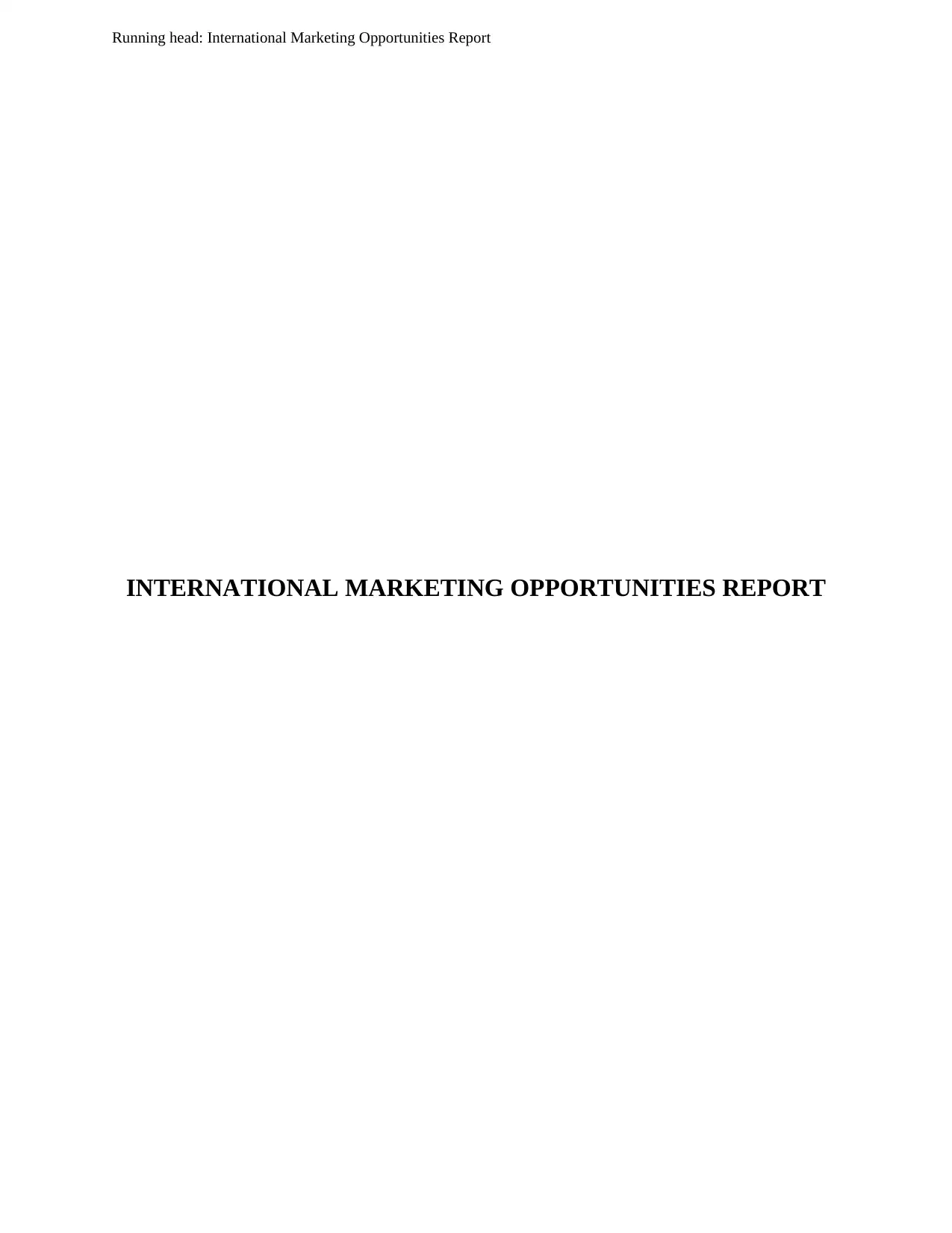
Running head: International Marketing Opportunities Report
INTERNATIONAL MARKETING OPPORTUNITIES REPORT
INTERNATIONAL MARKETING OPPORTUNITIES REPORT
Paraphrase This Document
Need a fresh take? Get an instant paraphrase of this document with our AI Paraphraser
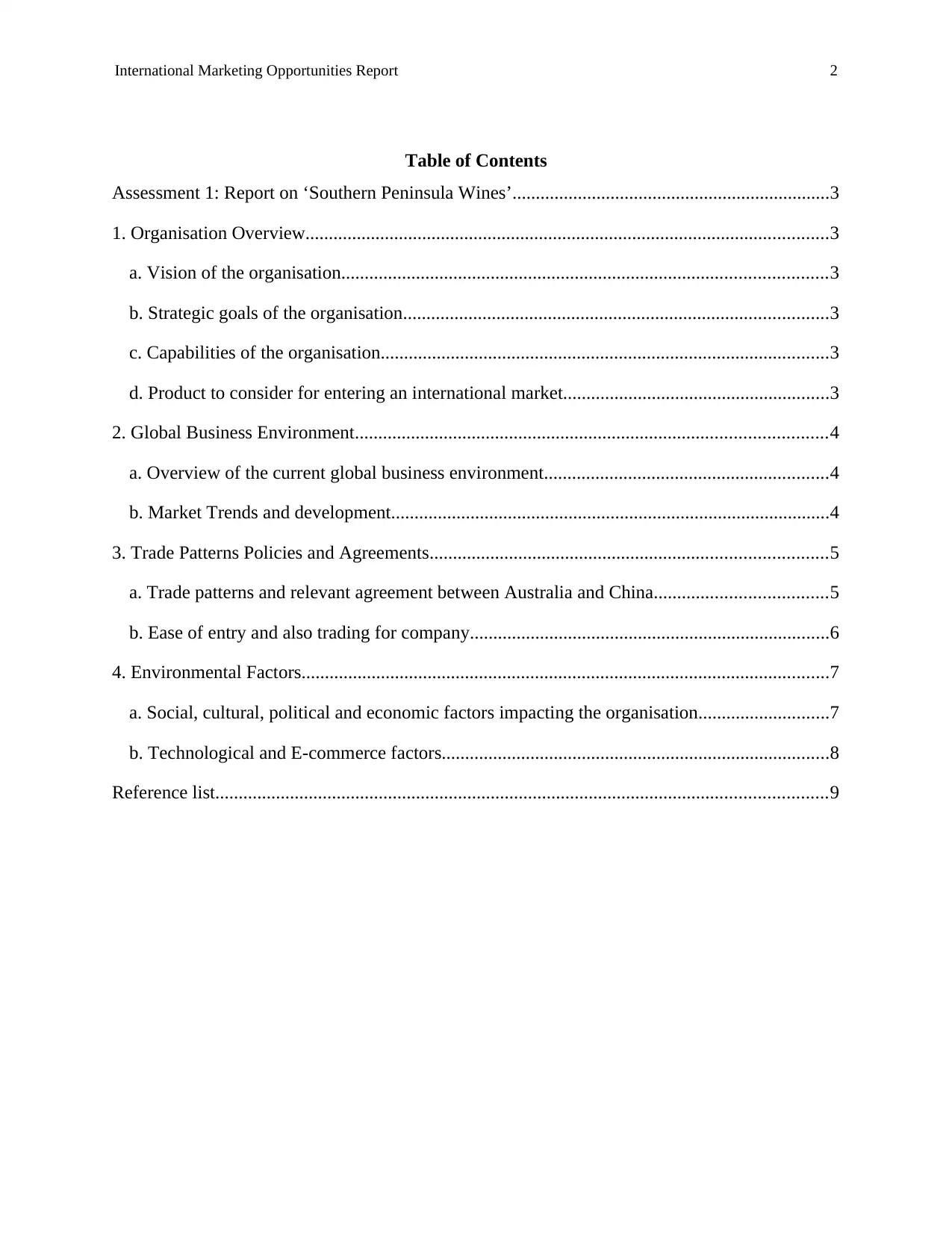
International Marketing Opportunities Report 2
Table of Contents
Assessment 1: Report on ‘Southern Peninsula Wines’....................................................................3
1. Organisation Overview................................................................................................................3
a. Vision of the organisation........................................................................................................3
b. Strategic goals of the organisation...........................................................................................3
c. Capabilities of the organisation................................................................................................3
d. Product to consider for entering an international market.........................................................3
2. Global Business Environment.....................................................................................................4
a. Overview of the current global business environment.............................................................4
b. Market Trends and development..............................................................................................4
3. Trade Patterns Policies and Agreements.....................................................................................5
a. Trade patterns and relevant agreement between Australia and China.....................................5
b. Ease of entry and also trading for company.............................................................................6
4. Environmental Factors.................................................................................................................7
a. Social, cultural, political and economic factors impacting the organisation............................7
b. Technological and E-commerce factors...................................................................................8
Reference list...................................................................................................................................9
Table of Contents
Assessment 1: Report on ‘Southern Peninsula Wines’....................................................................3
1. Organisation Overview................................................................................................................3
a. Vision of the organisation........................................................................................................3
b. Strategic goals of the organisation...........................................................................................3
c. Capabilities of the organisation................................................................................................3
d. Product to consider for entering an international market.........................................................3
2. Global Business Environment.....................................................................................................4
a. Overview of the current global business environment.............................................................4
b. Market Trends and development..............................................................................................4
3. Trade Patterns Policies and Agreements.....................................................................................5
a. Trade patterns and relevant agreement between Australia and China.....................................5
b. Ease of entry and also trading for company.............................................................................6
4. Environmental Factors.................................................................................................................7
a. Social, cultural, political and economic factors impacting the organisation............................7
b. Technological and E-commerce factors...................................................................................8
Reference list...................................................................................................................................9
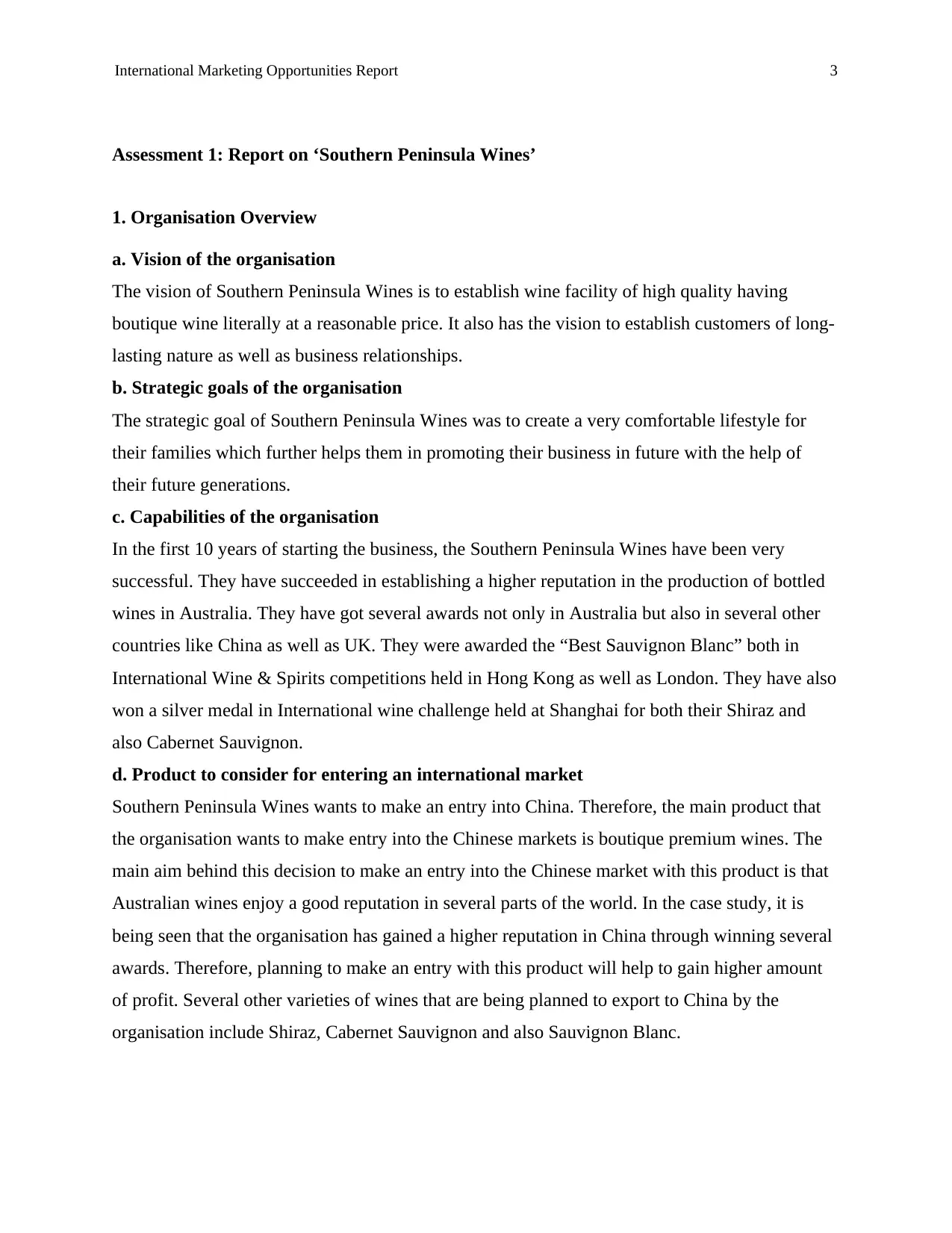
International Marketing Opportunities Report 3
Assessment 1: Report on ‘Southern Peninsula Wines’
1. Organisation Overview
a. Vision of the organisation
The vision of Southern Peninsula Wines is to establish wine facility of high quality having
boutique wine literally at a reasonable price. It also has the vision to establish customers of long-
lasting nature as well as business relationships.
b. Strategic goals of the organisation
The strategic goal of Southern Peninsula Wines was to create a very comfortable lifestyle for
their families which further helps them in promoting their business in future with the help of
their future generations.
c. Capabilities of the organisation
In the first 10 years of starting the business, the Southern Peninsula Wines have been very
successful. They have succeeded in establishing a higher reputation in the production of bottled
wines in Australia. They have got several awards not only in Australia but also in several other
countries like China as well as UK. They were awarded the “Best Sauvignon Blanc” both in
International Wine & Spirits competitions held in Hong Kong as well as London. They have also
won a silver medal in International wine challenge held at Shanghai for both their Shiraz and
also Cabernet Sauvignon.
d. Product to consider for entering an international market
Southern Peninsula Wines wants to make an entry into China. Therefore, the main product that
the organisation wants to make entry into the Chinese markets is boutique premium wines. The
main aim behind this decision to make an entry into the Chinese market with this product is that
Australian wines enjoy a good reputation in several parts of the world. In the case study, it is
being seen that the organisation has gained a higher reputation in China through winning several
awards. Therefore, planning to make an entry with this product will help to gain higher amount
of profit. Several other varieties of wines that are being planned to export to China by the
organisation include Shiraz, Cabernet Sauvignon and also Sauvignon Blanc.
Assessment 1: Report on ‘Southern Peninsula Wines’
1. Organisation Overview
a. Vision of the organisation
The vision of Southern Peninsula Wines is to establish wine facility of high quality having
boutique wine literally at a reasonable price. It also has the vision to establish customers of long-
lasting nature as well as business relationships.
b. Strategic goals of the organisation
The strategic goal of Southern Peninsula Wines was to create a very comfortable lifestyle for
their families which further helps them in promoting their business in future with the help of
their future generations.
c. Capabilities of the organisation
In the first 10 years of starting the business, the Southern Peninsula Wines have been very
successful. They have succeeded in establishing a higher reputation in the production of bottled
wines in Australia. They have got several awards not only in Australia but also in several other
countries like China as well as UK. They were awarded the “Best Sauvignon Blanc” both in
International Wine & Spirits competitions held in Hong Kong as well as London. They have also
won a silver medal in International wine challenge held at Shanghai for both their Shiraz and
also Cabernet Sauvignon.
d. Product to consider for entering an international market
Southern Peninsula Wines wants to make an entry into China. Therefore, the main product that
the organisation wants to make entry into the Chinese markets is boutique premium wines. The
main aim behind this decision to make an entry into the Chinese market with this product is that
Australian wines enjoy a good reputation in several parts of the world. In the case study, it is
being seen that the organisation has gained a higher reputation in China through winning several
awards. Therefore, planning to make an entry with this product will help to gain higher amount
of profit. Several other varieties of wines that are being planned to export to China by the
organisation include Shiraz, Cabernet Sauvignon and also Sauvignon Blanc.
⊘ This is a preview!⊘
Do you want full access?
Subscribe today to unlock all pages.

Trusted by 1+ million students worldwide
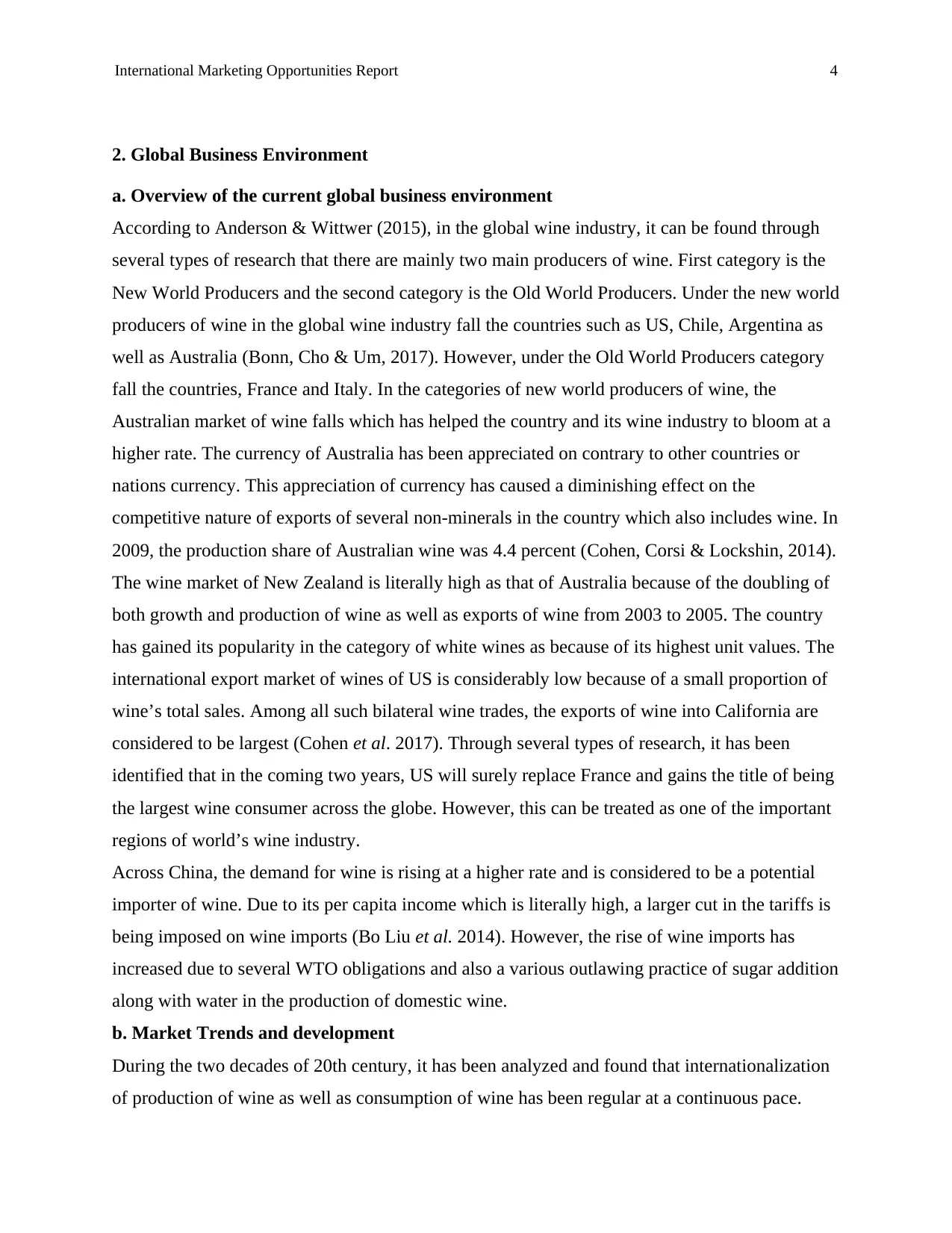
International Marketing Opportunities Report 4
2. Global Business Environment
a. Overview of the current global business environment
According to Anderson & Wittwer (2015), in the global wine industry, it can be found through
several types of research that there are mainly two main producers of wine. First category is the
New World Producers and the second category is the Old World Producers. Under the new world
producers of wine in the global wine industry fall the countries such as US, Chile, Argentina as
well as Australia (Bonn, Cho & Um, 2017). However, under the Old World Producers category
fall the countries, France and Italy. In the categories of new world producers of wine, the
Australian market of wine falls which has helped the country and its wine industry to bloom at a
higher rate. The currency of Australia has been appreciated on contrary to other countries or
nations currency. This appreciation of currency has caused a diminishing effect on the
competitive nature of exports of several non-minerals in the country which also includes wine. In
2009, the production share of Australian wine was 4.4 percent (Cohen, Corsi & Lockshin, 2014).
The wine market of New Zealand is literally high as that of Australia because of the doubling of
both growth and production of wine as well as exports of wine from 2003 to 2005. The country
has gained its popularity in the category of white wines as because of its highest unit values. The
international export market of wines of US is considerably low because of a small proportion of
wine’s total sales. Among all such bilateral wine trades, the exports of wine into California are
considered to be largest (Cohen et al. 2017). Through several types of research, it has been
identified that in the coming two years, US will surely replace France and gains the title of being
the largest wine consumer across the globe. However, this can be treated as one of the important
regions of world’s wine industry.
Across China, the demand for wine is rising at a higher rate and is considered to be a potential
importer of wine. Due to its per capita income which is literally high, a larger cut in the tariffs is
being imposed on wine imports (Bo Liu et al. 2014). However, the rise of wine imports has
increased due to several WTO obligations and also a various outlawing practice of sugar addition
along with water in the production of domestic wine.
b. Market Trends and development
During the two decades of 20th century, it has been analyzed and found that internationalization
of production of wine as well as consumption of wine has been regular at a continuous pace.
2. Global Business Environment
a. Overview of the current global business environment
According to Anderson & Wittwer (2015), in the global wine industry, it can be found through
several types of research that there are mainly two main producers of wine. First category is the
New World Producers and the second category is the Old World Producers. Under the new world
producers of wine in the global wine industry fall the countries such as US, Chile, Argentina as
well as Australia (Bonn, Cho & Um, 2017). However, under the Old World Producers category
fall the countries, France and Italy. In the categories of new world producers of wine, the
Australian market of wine falls which has helped the country and its wine industry to bloom at a
higher rate. The currency of Australia has been appreciated on contrary to other countries or
nations currency. This appreciation of currency has caused a diminishing effect on the
competitive nature of exports of several non-minerals in the country which also includes wine. In
2009, the production share of Australian wine was 4.4 percent (Cohen, Corsi & Lockshin, 2014).
The wine market of New Zealand is literally high as that of Australia because of the doubling of
both growth and production of wine as well as exports of wine from 2003 to 2005. The country
has gained its popularity in the category of white wines as because of its highest unit values. The
international export market of wines of US is considerably low because of a small proportion of
wine’s total sales. Among all such bilateral wine trades, the exports of wine into California are
considered to be largest (Cohen et al. 2017). Through several types of research, it has been
identified that in the coming two years, US will surely replace France and gains the title of being
the largest wine consumer across the globe. However, this can be treated as one of the important
regions of world’s wine industry.
Across China, the demand for wine is rising at a higher rate and is considered to be a potential
importer of wine. Due to its per capita income which is literally high, a larger cut in the tariffs is
being imposed on wine imports (Bo Liu et al. 2014). However, the rise of wine imports has
increased due to several WTO obligations and also a various outlawing practice of sugar addition
along with water in the production of domestic wine.
b. Market Trends and development
During the two decades of 20th century, it has been analyzed and found that internationalization
of production of wine as well as consumption of wine has been regular at a continuous pace.
Paraphrase This Document
Need a fresh take? Get an instant paraphrase of this document with our AI Paraphraser
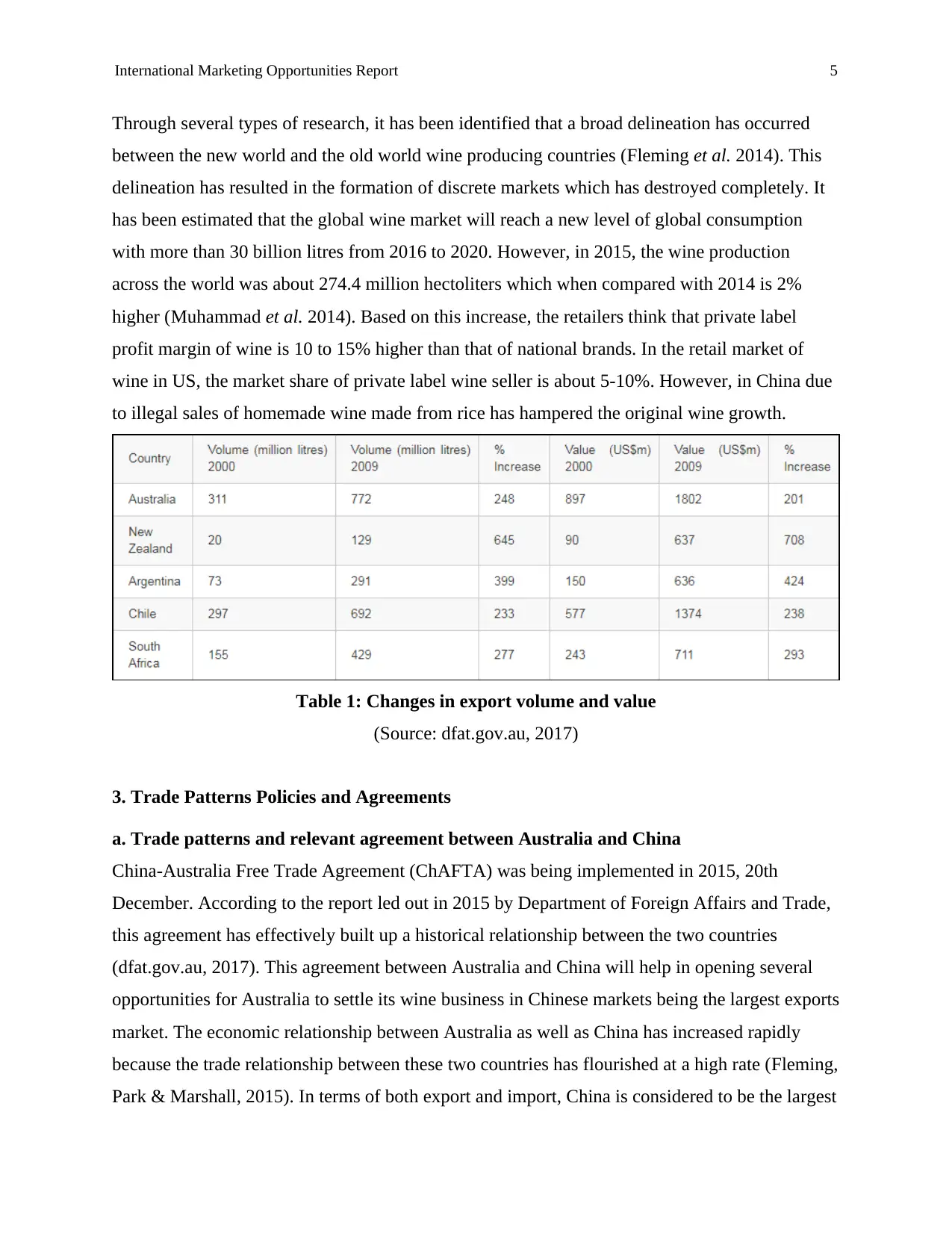
International Marketing Opportunities Report 5
Through several types of research, it has been identified that a broad delineation has occurred
between the new world and the old world wine producing countries (Fleming et al. 2014). This
delineation has resulted in the formation of discrete markets which has destroyed completely. It
has been estimated that the global wine market will reach a new level of global consumption
with more than 30 billion litres from 2016 to 2020. However, in 2015, the wine production
across the world was about 274.4 million hectoliters which when compared with 2014 is 2%
higher (Muhammad et al. 2014). Based on this increase, the retailers think that private label
profit margin of wine is 10 to 15% higher than that of national brands. In the retail market of
wine in US, the market share of private label wine seller is about 5-10%. However, in China due
to illegal sales of homemade wine made from rice has hampered the original wine growth.
Table 1: Changes in export volume and value
(Source: dfat.gov.au, 2017)
3. Trade Patterns Policies and Agreements
a. Trade patterns and relevant agreement between Australia and China
China-Australia Free Trade Agreement (ChAFTA) was being implemented in 2015, 20th
December. According to the report led out in 2015 by Department of Foreign Affairs and Trade,
this agreement has effectively built up a historical relationship between the two countries
(dfat.gov.au, 2017). This agreement between Australia and China will help in opening several
opportunities for Australia to settle its wine business in Chinese markets being the largest exports
market. The economic relationship between Australia as well as China has increased rapidly
because the trade relationship between these two countries has flourished at a high rate (Fleming,
Park & Marshall, 2015). In terms of both export and import, China is considered to be the largest
Through several types of research, it has been identified that a broad delineation has occurred
between the new world and the old world wine producing countries (Fleming et al. 2014). This
delineation has resulted in the formation of discrete markets which has destroyed completely. It
has been estimated that the global wine market will reach a new level of global consumption
with more than 30 billion litres from 2016 to 2020. However, in 2015, the wine production
across the world was about 274.4 million hectoliters which when compared with 2014 is 2%
higher (Muhammad et al. 2014). Based on this increase, the retailers think that private label
profit margin of wine is 10 to 15% higher than that of national brands. In the retail market of
wine in US, the market share of private label wine seller is about 5-10%. However, in China due
to illegal sales of homemade wine made from rice has hampered the original wine growth.
Table 1: Changes in export volume and value
(Source: dfat.gov.au, 2017)
3. Trade Patterns Policies and Agreements
a. Trade patterns and relevant agreement between Australia and China
China-Australia Free Trade Agreement (ChAFTA) was being implemented in 2015, 20th
December. According to the report led out in 2015 by Department of Foreign Affairs and Trade,
this agreement has effectively built up a historical relationship between the two countries
(dfat.gov.au, 2017). This agreement between Australia and China will help in opening several
opportunities for Australia to settle its wine business in Chinese markets being the largest exports
market. The economic relationship between Australia as well as China has increased rapidly
because the trade relationship between these two countries has flourished at a high rate (Fleming,
Park & Marshall, 2015). In terms of both export and import, China is considered to be the largest

International Marketing Opportunities Report 6
trading partner of Australia. On the other hand, Australia is considered to be the 6th largest
trading partner of China in terms of merchandise.
Figure: China’s Share of Australian total merchandise trade
(Source: dfat.gov.au, 2017)
Since the starting of the policy termed as “go global”, Australia is being considered as the
topmost destination of China countering foreign direct investment (Curran & Thorpe, 2015).
Investment with China by Australia has started since 1979 and is considered to be the earliest
nations among whom investment occurred first. However, recently the investment done by
Australia with China has improved with 1.4 percent of total stock.
b. Ease of entry and also trading for company
Being bound by Free Trade Agreement with China, wine consumption in Australia has decreased
in 2013 miserably after 10 years of continuous growth. In 2014 approximately, the Australian
Wine exports have decreased by 12 percent (Nallaperuma, Bandyopadhyay & Lockshin, 2017).
However, considering the Free Trade Agreement will help wine companies of Australia to get
better access in the most important markets across the world and gain a strong competitive
position and also two-way investments.
trading partner of Australia. On the other hand, Australia is considered to be the 6th largest
trading partner of China in terms of merchandise.
Figure: China’s Share of Australian total merchandise trade
(Source: dfat.gov.au, 2017)
Since the starting of the policy termed as “go global”, Australia is being considered as the
topmost destination of China countering foreign direct investment (Curran & Thorpe, 2015).
Investment with China by Australia has started since 1979 and is considered to be the earliest
nations among whom investment occurred first. However, recently the investment done by
Australia with China has improved with 1.4 percent of total stock.
b. Ease of entry and also trading for company
Being bound by Free Trade Agreement with China, wine consumption in Australia has decreased
in 2013 miserably after 10 years of continuous growth. In 2014 approximately, the Australian
Wine exports have decreased by 12 percent (Nallaperuma, Bandyopadhyay & Lockshin, 2017).
However, considering the Free Trade Agreement will help wine companies of Australia to get
better access in the most important markets across the world and gain a strong competitive
position and also two-way investments.
⊘ This is a preview!⊘
Do you want full access?
Subscribe today to unlock all pages.

Trusted by 1+ million students worldwide
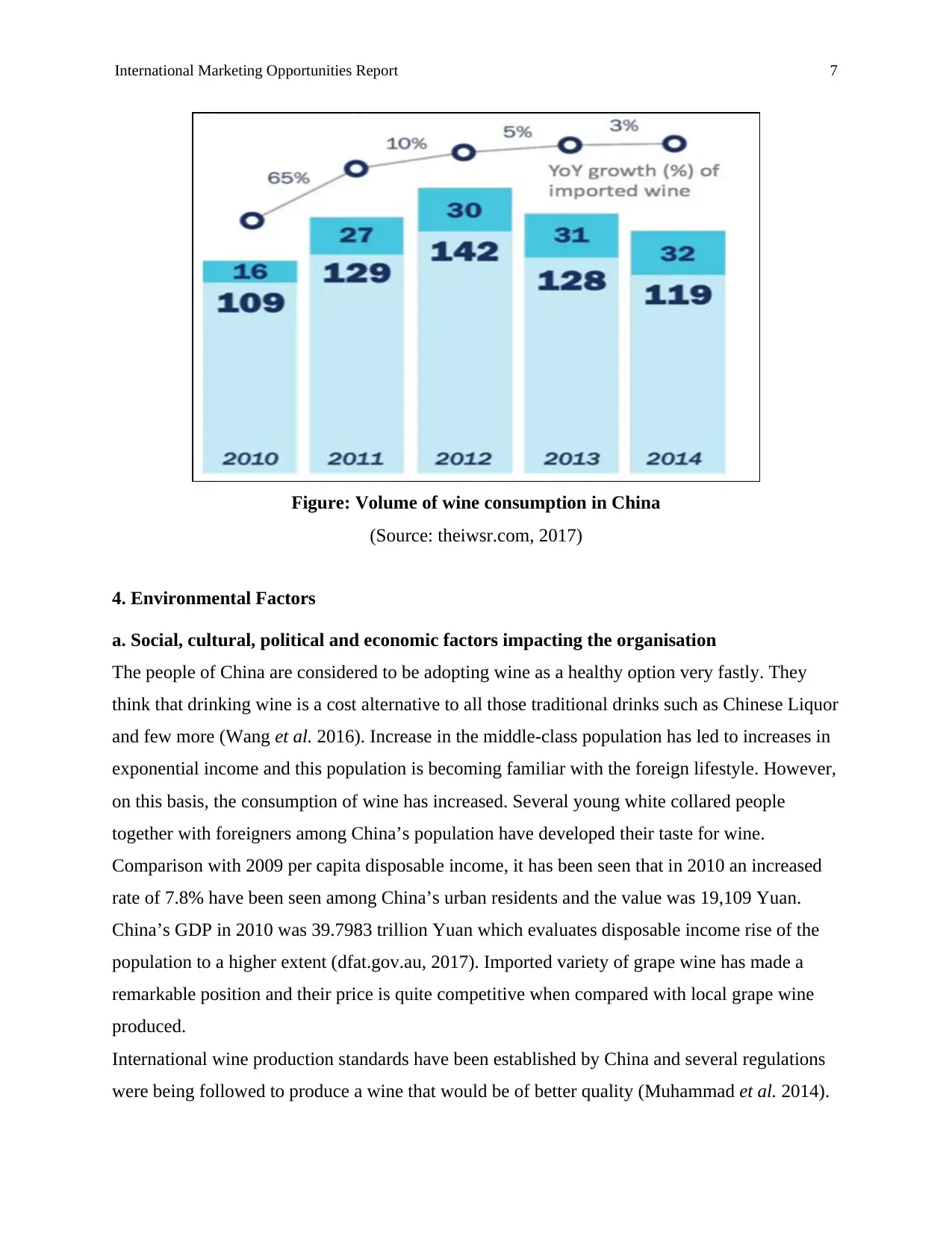
International Marketing Opportunities Report 7
Figure: Volume of wine consumption in China
(Source: theiwsr.com, 2017)
4. Environmental Factors
a. Social, cultural, political and economic factors impacting the organisation
The people of China are considered to be adopting wine as a healthy option very fastly. They
think that drinking wine is a cost alternative to all those traditional drinks such as Chinese Liquor
and few more (Wang et al. 2016). Increase in the middle-class population has led to increases in
exponential income and this population is becoming familiar with the foreign lifestyle. However,
on this basis, the consumption of wine has increased. Several young white collared people
together with foreigners among China’s population have developed their taste for wine.
Comparison with 2009 per capita disposable income, it has been seen that in 2010 an increased
rate of 7.8% have been seen among China’s urban residents and the value was 19,109 Yuan.
China’s GDP in 2010 was 39.7983 trillion Yuan which evaluates disposable income rise of the
population to a higher extent (dfat.gov.au, 2017). Imported variety of grape wine has made a
remarkable position and their price is quite competitive when compared with local grape wine
produced.
International wine production standards have been established by China and several regulations
were being followed to produce a wine that would be of better quality (Muhammad et al. 2014).
Figure: Volume of wine consumption in China
(Source: theiwsr.com, 2017)
4. Environmental Factors
a. Social, cultural, political and economic factors impacting the organisation
The people of China are considered to be adopting wine as a healthy option very fastly. They
think that drinking wine is a cost alternative to all those traditional drinks such as Chinese Liquor
and few more (Wang et al. 2016). Increase in the middle-class population has led to increases in
exponential income and this population is becoming familiar with the foreign lifestyle. However,
on this basis, the consumption of wine has increased. Several young white collared people
together with foreigners among China’s population have developed their taste for wine.
Comparison with 2009 per capita disposable income, it has been seen that in 2010 an increased
rate of 7.8% have been seen among China’s urban residents and the value was 19,109 Yuan.
China’s GDP in 2010 was 39.7983 trillion Yuan which evaluates disposable income rise of the
population to a higher extent (dfat.gov.au, 2017). Imported variety of grape wine has made a
remarkable position and their price is quite competitive when compared with local grape wine
produced.
International wine production standards have been established by China and several regulations
were being followed to produce a wine that would be of better quality (Muhammad et al. 2014).
Paraphrase This Document
Need a fresh take? Get an instant paraphrase of this document with our AI Paraphraser
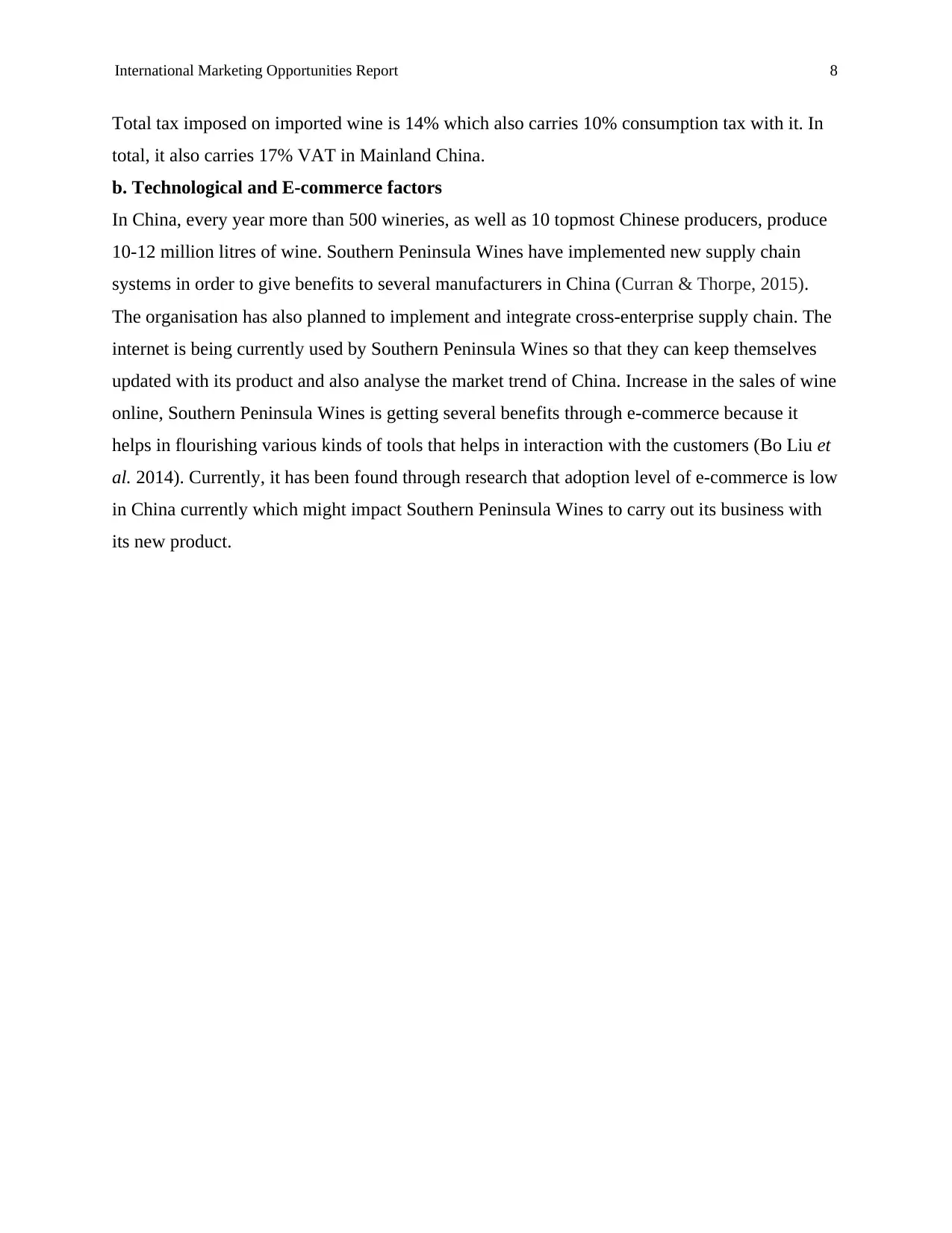
International Marketing Opportunities Report 8
Total tax imposed on imported wine is 14% which also carries 10% consumption tax with it. In
total, it also carries 17% VAT in Mainland China.
b. Technological and E-commerce factors
In China, every year more than 500 wineries, as well as 10 topmost Chinese producers, produce
10-12 million litres of wine. Southern Peninsula Wines have implemented new supply chain
systems in order to give benefits to several manufacturers in China (Curran & Thorpe, 2015).
The organisation has also planned to implement and integrate cross-enterprise supply chain. The
internet is being currently used by Southern Peninsula Wines so that they can keep themselves
updated with its product and also analyse the market trend of China. Increase in the sales of wine
online, Southern Peninsula Wines is getting several benefits through e-commerce because it
helps in flourishing various kinds of tools that helps in interaction with the customers (Bo Liu et
al. 2014). Currently, it has been found through research that adoption level of e-commerce is low
in China currently which might impact Southern Peninsula Wines to carry out its business with
its new product.
Total tax imposed on imported wine is 14% which also carries 10% consumption tax with it. In
total, it also carries 17% VAT in Mainland China.
b. Technological and E-commerce factors
In China, every year more than 500 wineries, as well as 10 topmost Chinese producers, produce
10-12 million litres of wine. Southern Peninsula Wines have implemented new supply chain
systems in order to give benefits to several manufacturers in China (Curran & Thorpe, 2015).
The organisation has also planned to implement and integrate cross-enterprise supply chain. The
internet is being currently used by Southern Peninsula Wines so that they can keep themselves
updated with its product and also analyse the market trend of China. Increase in the sales of wine
online, Southern Peninsula Wines is getting several benefits through e-commerce because it
helps in flourishing various kinds of tools that helps in interaction with the customers (Bo Liu et
al. 2014). Currently, it has been found through research that adoption level of e-commerce is low
in China currently which might impact Southern Peninsula Wines to carry out its business with
its new product.
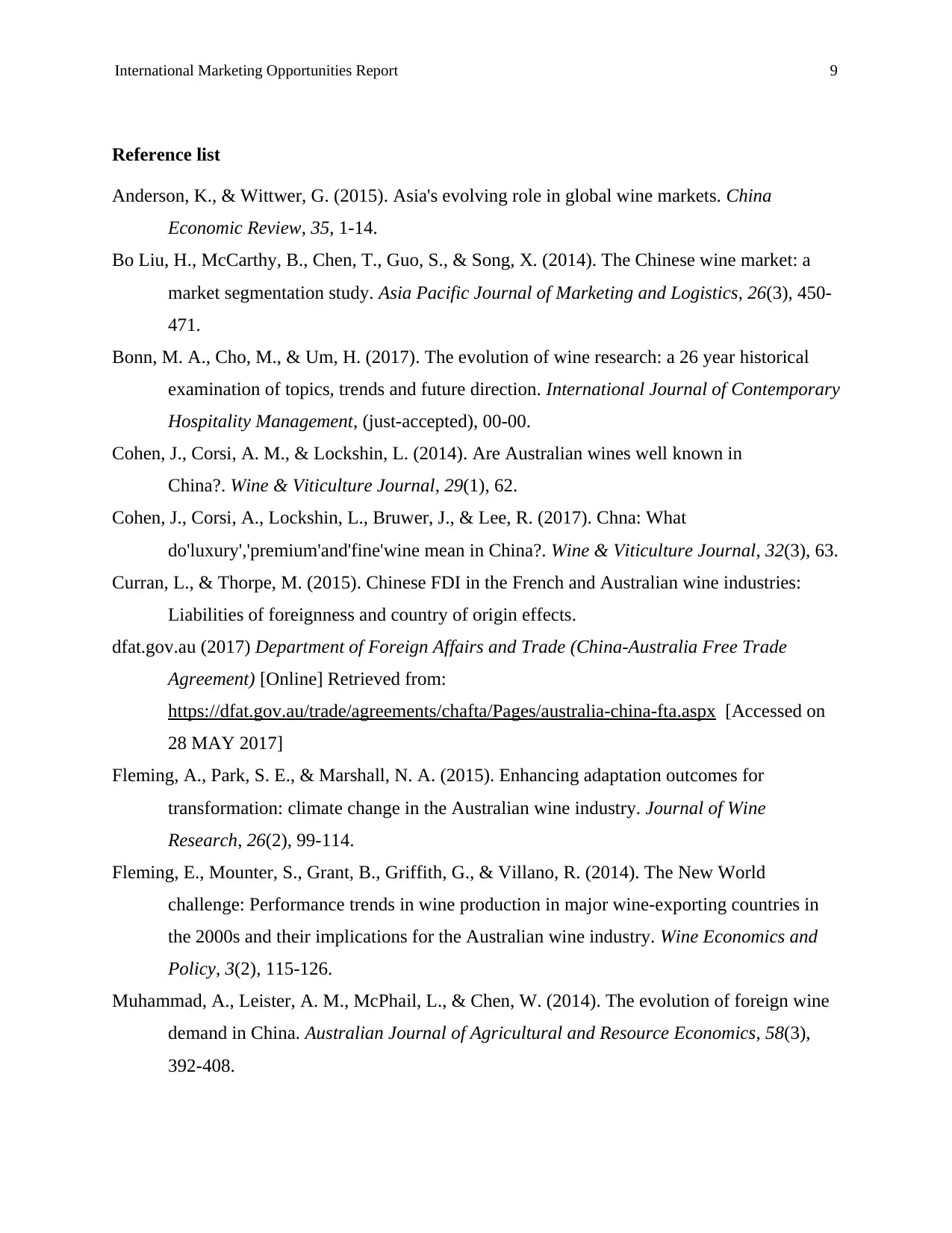
International Marketing Opportunities Report 9
Reference list
Anderson, K., & Wittwer, G. (2015). Asia's evolving role in global wine markets. China
Economic Review, 35, 1-14.
Bo Liu, H., McCarthy, B., Chen, T., Guo, S., & Song, X. (2014). The Chinese wine market: a
market segmentation study. Asia Pacific Journal of Marketing and Logistics, 26(3), 450-
471.
Bonn, M. A., Cho, M., & Um, H. (2017). The evolution of wine research: a 26 year historical
examination of topics, trends and future direction. International Journal of Contemporary
Hospitality Management, (just-accepted), 00-00.
Cohen, J., Corsi, A. M., & Lockshin, L. (2014). Are Australian wines well known in
China?. Wine & Viticulture Journal, 29(1), 62.
Cohen, J., Corsi, A., Lockshin, L., Bruwer, J., & Lee, R. (2017). Chna: What
do'luxury','premium'and'fine'wine mean in China?. Wine & Viticulture Journal, 32(3), 63.
Curran, L., & Thorpe, M. (2015). Chinese FDI in the French and Australian wine industries:
Liabilities of foreignness and country of origin effects.
dfat.gov.au (2017) Department of Foreign Affairs and Trade (China-Australia Free Trade
Agreement) [Online] Retrieved from:
https://dfat.gov.au/trade/agreements/chafta/Pages/australia-china-fta.aspx [Accessed on
28 MAY 2017]
Fleming, A., Park, S. E., & Marshall, N. A. (2015). Enhancing adaptation outcomes for
transformation: climate change in the Australian wine industry. Journal of Wine
Research, 26(2), 99-114.
Fleming, E., Mounter, S., Grant, B., Griffith, G., & Villano, R. (2014). The New World
challenge: Performance trends in wine production in major wine-exporting countries in
the 2000s and their implications for the Australian wine industry. Wine Economics and
Policy, 3(2), 115-126.
Muhammad, A., Leister, A. M., McPhail, L., & Chen, W. (2014). The evolution of foreign wine
demand in China. Australian Journal of Agricultural and Resource Economics, 58(3),
392-408.
Reference list
Anderson, K., & Wittwer, G. (2015). Asia's evolving role in global wine markets. China
Economic Review, 35, 1-14.
Bo Liu, H., McCarthy, B., Chen, T., Guo, S., & Song, X. (2014). The Chinese wine market: a
market segmentation study. Asia Pacific Journal of Marketing and Logistics, 26(3), 450-
471.
Bonn, M. A., Cho, M., & Um, H. (2017). The evolution of wine research: a 26 year historical
examination of topics, trends and future direction. International Journal of Contemporary
Hospitality Management, (just-accepted), 00-00.
Cohen, J., Corsi, A. M., & Lockshin, L. (2014). Are Australian wines well known in
China?. Wine & Viticulture Journal, 29(1), 62.
Cohen, J., Corsi, A., Lockshin, L., Bruwer, J., & Lee, R. (2017). Chna: What
do'luxury','premium'and'fine'wine mean in China?. Wine & Viticulture Journal, 32(3), 63.
Curran, L., & Thorpe, M. (2015). Chinese FDI in the French and Australian wine industries:
Liabilities of foreignness and country of origin effects.
dfat.gov.au (2017) Department of Foreign Affairs and Trade (China-Australia Free Trade
Agreement) [Online] Retrieved from:
https://dfat.gov.au/trade/agreements/chafta/Pages/australia-china-fta.aspx [Accessed on
28 MAY 2017]
Fleming, A., Park, S. E., & Marshall, N. A. (2015). Enhancing adaptation outcomes for
transformation: climate change in the Australian wine industry. Journal of Wine
Research, 26(2), 99-114.
Fleming, E., Mounter, S., Grant, B., Griffith, G., & Villano, R. (2014). The New World
challenge: Performance trends in wine production in major wine-exporting countries in
the 2000s and their implications for the Australian wine industry. Wine Economics and
Policy, 3(2), 115-126.
Muhammad, A., Leister, A. M., McPhail, L., & Chen, W. (2014). The evolution of foreign wine
demand in China. Australian Journal of Agricultural and Resource Economics, 58(3),
392-408.
⊘ This is a preview!⊘
Do you want full access?
Subscribe today to unlock all pages.

Trusted by 1+ million students worldwide

International Marketing Opportunities Report
10
Nallaperuma, K., Bandyopadhyay, A., & Lockshin, L. (2017). A comparative analysis of
experts’ and consumers’ perceptions of regionality in Australian wine purchase
decisions. Journal of Wine Research, 28(3), 194-215.
theiwsr.com (2017) ISWR [Online] Retrieved from: https://www.theiwsr.com/index.aspx
[Accessed on 20 JULY 2017]
Wang, J., Capone, D. L., Wilkinson, K. L., & Jeffery, D. W. (2016). Rosé wine volatile
composition and the preferences of Chinese wine professionals. Food chemistry, 202,
507-517.
10
Nallaperuma, K., Bandyopadhyay, A., & Lockshin, L. (2017). A comparative analysis of
experts’ and consumers’ perceptions of regionality in Australian wine purchase
decisions. Journal of Wine Research, 28(3), 194-215.
theiwsr.com (2017) ISWR [Online] Retrieved from: https://www.theiwsr.com/index.aspx
[Accessed on 20 JULY 2017]
Wang, J., Capone, D. L., Wilkinson, K. L., & Jeffery, D. W. (2016). Rosé wine volatile
composition and the preferences of Chinese wine professionals. Food chemistry, 202,
507-517.
1 out of 10
Related Documents
Your All-in-One AI-Powered Toolkit for Academic Success.
+13062052269
info@desklib.com
Available 24*7 on WhatsApp / Email
![[object Object]](/_next/static/media/star-bottom.7253800d.svg)
Unlock your academic potential
Copyright © 2020–2026 A2Z Services. All Rights Reserved. Developed and managed by ZUCOL.



